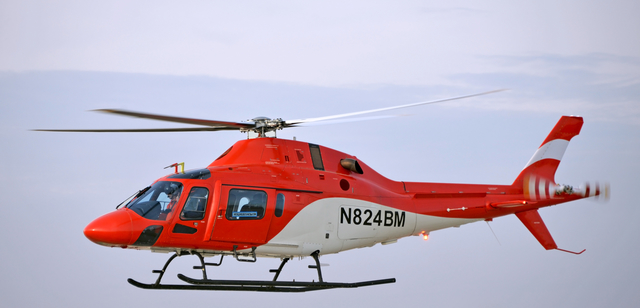Leonardo’s pitch for the US Navy’s TH-XX helicopter trainer replacement competition will focus on what it said is the affordability of its light-weight, single-engined TH-119 helicopter.
Based on the commercial AgustaWestland AW119, the Italian company said the helicopter’s simple and rugged design, as well as its single engine, make it the most practical and cost efficient aircraft for training naval aviators. The USN posted its request for proposals on 28 January, asking for 130 helicopters to replace its legacy fleet of Bell TH-57B/C Sea Ranger trainer helicopters. The contract award is anticipated in the first quarter of the government 2020 fiscal year.
Leonardo is arguing that a single-engined helicopter makes more sense for training missions than a dual-turbine powered aircraft.
“It is an undergraduate training mission, and cost does matter to the Navy when it comes to this mission. It is not a combat system,” said Andrew Gappy, Leonardo director of US government sales. “We’ve done a couple of assessments that looked at the market and on average a single engine is about 20 to 25% cheaper per hour than the nearest twin-engined.”
Moreover, Gappy says the Navy’s history of buying single-engined aircraft suggests it would likely agree.
“The Navy doesn’t do any overwater training; it’s mostly over land. If you look at the aircraft the Navy does undergraduate training with now, it’s the single-engined T-45, the single-engined TH-57, the single-engined T-6, and the most-expensive jet on the planet, [the F-35]… is a single-engined aircraft,” he says. “I think they see the benefit in keeping it simple.”

Leonardo TH-119 first flight
Leonardo
Moreover, Gappy says a single-engined aircraft is better for practicing autorotations.
“There aren’t any twin-engineds in the market that I know of that can do, in a repetitive way, touchdown [autorotations],” he says, noting the need for students to practice the emergency manoeuvre over and over. “The problem is the wear and tear on the aircraft when it’s doing continuous autorotations. It’s due to the heavier weight. The wear and tear is due to the fact that you’ve two different engines that have to both get rolled to idle and brought back online at the same time.”
And, Leonardo adds the TH-119’s metal frame is preferable to helicopters that might incorporate composite materials.
“The TH-119 has a mostly metal airframe, unlike a lot of aircraft today that are built with composites,” Gappy says. “Composites are great lightweight materials, but they are extremely difficult to repair.”
Leonardo says the TH-119 is scheduled to achieve full Federal Aviation Administration instrument flight rules (IFR) certification in early 2019. The helicopter made its first flight on 20 December at the company’s Philadelphia plant.
The TH-119’s likely competition for the USN’s trainer helicopter contract includes the single-engined Bell 407GXi and Airbus Helicopters’ twin-engined H135.
Source: FlightGlobal.com



















